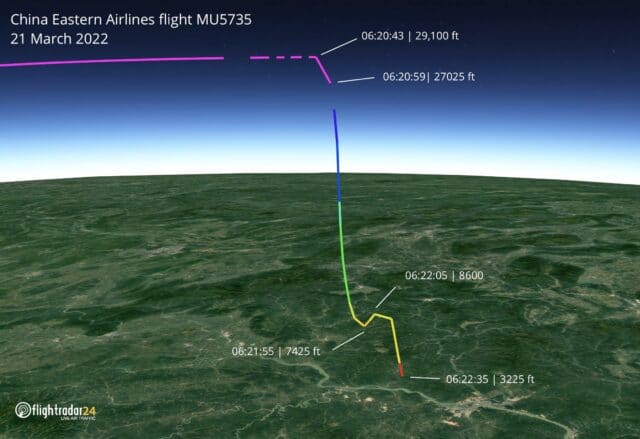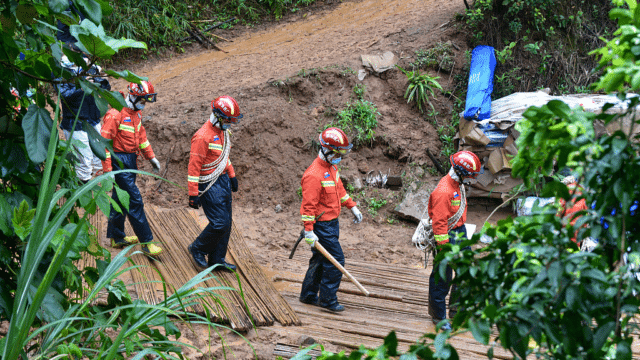Initial Information on China Eastern Airlines flight 5735
On Monday, the 21st of March 2022, China Eastern Airlines flight 5735 crashed into mountainous terrain during a scheduled passenger flight from Kunming to Guangzhou in the People’s Republic of China.
There were 132 souls onboard with no survivors. The search for life continues in difficult terrain but after five days, it seems unlikely.
The aircraft was a Boeing 737-89P, a twin-engine, single-aisle passenger jet, which was registered as B-1791. It was delivered new to China Eastern Airlines, one of the three largest airlines in mainland China, in 2015. A spokesman for the airline stated that it was up-to-date on maintenance and no irregularities had been logged.

Flight 5735 departed Kunming Changshui International Airport, which serves the capital of the Yunnan province and is the hub for China Eastern Airlines, at 13:00 local time (0500 GMT). The estimated time of arrival at Guangzhou Baiyun International Airport in the Guangdong province was 15:05. The weather was cloudy but the visibility was good.
There were nine crew on the flight: three pilots, five cabin crew and a security guard.
The captain of the flight had 6,709 hours on type. The pilot listed as the first officer with 31,769 flight hours was one of China’s first commercial pilots and the most experienced pilot at China Eastern Airlines, where he was a flight instructor. He had trained over a hundred captains, including the captain of this flight. The pilot listed as the second officer was his student. This pilot had only 556 hours flight time and Chinese media have reported that he was on the flight for observation, so he may not have been anywhere near the controls.
The initial climb to cruise was uneventful and all Air Traffic Control interactions were described later as normal until the point where the flight crew stopped responding.
Halfway through the flight, at 14:17 local, the aircraft entered the control zone of Guangzhou. It is not clear to me whether the flight crew contacted the Guangzhou controllers, let alone whether they might have been given any instructions to change altitude or start their descent.
Three minutes later, at 14:20, air traffic controllers noticed that China Eastern Airlines flight 5735 was descending rapidly. They immediately attempted to contact the flight crew. There was no reply.
Flightradar24’s playback of the flight based on ADS-B data shows the sudden descent as starting at 06:20 UTC: the Boeing seems to plunge from 29,125 feet to 9,057 feet, with the next updates showing 6,525 feet, 4375 feet and, finally, 3,225 feet before the flight disappears. The descent took place over three minutes, with a ground speed of 450 knots reducing to 376 knots. Note that this is groundspeed, not airspeed, so as the aircraft’s trajectory became vertical, it wasn’t necessarily slowing down so much as losing forward momentum.
This is the data that is most often cited in the mainstream media. However, flightradar24 have published an analysis of the raw data which gives more information:
MU5735 departed Kunming at 05:16 UTC and reached a cruising altitude of 29,100 feet at 05:27 UTC. The flight continued normally until 06:20 UTC when the aircraft began a rapid descent to 7425 ft AMSL before recovering to 8600 ft AMSL. The aircraft then descended rapidly again. The last ADS-B message received by Flightradar24 from MU5735 was at 06:22:35Z.972 UTC at an altitude of 3225 ft AMSL.

If the ADS-B data reflects reality, then that recovery of a thousand feet is very interesting. It could be a sudden configuration change (pieces breaking off the aircraft) but it seems more likely that someone briefly managed to successfully arrest the descent before losing control again.
Two videos have been shared on social media as showing the final moments of the descent. ChinaAviationReview has shared both: CCTV footage from a local mining operation and dashcam footage with no attribution.
Dash cam footage pic.twitter.com/w8iOzHblXE
— ChinaAviationReview (@ChinaAvReview) March 21, 2022
The aircraft crashed at high speed into mountainous terrain near the city of Wuzhou in Guangxi. Local residents heard a loud explosion and reported a massive bamboo fire in the area. Local firefighters arrived at 15:05 with more being dispatched from outside the area at 16:40. The fire was finally extinguished at 17:25.
Once the fire was out, rescuers approached the site from three directions and found debris scattered around a deep pit scarred into the slope by the impact. Most of the wreckage was discovered within a 30-metre area around the impact site which is said to be almost 20-metres deep. The terrain is muddy and steep and the weather is wet: pumps have been installed to keep the pit from flooding. Access is limited to a single road.
Chinese News Service, a state news agency, has posted a video showing the crash site:
Updates are being published on CGTN’s live news page, the official English-language Chinese news service in Beijing, however, it says that they are still looking for possible survivors which seems unlikely. CGTN is also broadcasting a daytime stream from the search site; depending on when you view it, you may be seeing yesterday’s broadcast:
The Honeywell cockpit voice recorder was recovered on Wednesday about 20 metres from the main impact area. The bright orange exterior of the “black box” is severely damaged but the head of the Chinese aviation safety office described the unit as “relatively complete”. The CVR has been sent to Beijing; it has not yet been confirmed whether any data can be recovered as the memory chip is damaged.

The flight data recorder has not yet been found.
In an interesting twist, yesterday, a farmer discovered a 130 cm x 10 cm metal strip in a paddy located 10 kilometres away from the impact site. Investigators report that this fragment may have come from the accident aircraft. They have broadened the search area in hopes of finding more pieces of the aircraft which might explain what happened.
Aljazeera reports that the China Eastern group grounded its fleet of Boeing 737-800s, with 89% of the airline’s flights cancelled on the day after the crash. China Eastern Airline’s company report lists 289 Boeing 737-series in their fleet of 751 aircraft. Estimates of 737-800s in the fleet range from 109 to 225.
China has one of the best airline safety records in the world, with no major incidents in over a decade. Before the pandemic, it was considered one of the world’s fastest-growing aviation markets. Now, however, local media reports that people are cancelling their flights and opting for high-speed rail for domestic travel.
The Civil Aviation Administration of China (CAAC) has designated an emergency task force to investigate the crash. The NTSB in the US has been invited to take part in the investigation and has appointed a senior official as their representative in the accident inquiries. Boeing has offered the full support of their technical experts.
However, the government of the People’s Republic of China requires an antigen test fourteen days before the flight as well as two to three weeks quarantine upon arrival. This will hamper the ability of US investigators to meaningfully take part in the preliminary investigation.

Realistically, there are three likely root causes of this accident:
- Structural damage caused by faulty maintenance or some external factor
- A deliberate action by a member of the flight crew
- Sudden loss of power (bird strike or engine malfunction) followed by an inappropriate recovery by the flight crew
That’s a very broad range there which could range from anything from spatial illusions to catastrophic failure of a critical flight control surface to deliberate sabotage. Until the preliminary report is released (30 days after the accident), it will be difficult to narrow it down. If the flight data recorder isn’t found, it may be impossible.








This is difficult to comment on because so little is known. That also means there’s no grounds to speculate about pilot error or worse; there’s not enough evidence to justify hurting the families of the deceased over such accusations.
This crash was unsurvivable; the only possibility would have been to depart the aircraft in the air, and falling out of an airplane without a parachute is only rarely followed by a recovery.
The crash is such that even the flight data recorder has not been recovered yet; the cockpit voice recorder is being analysed. It doesn’t need to be complete or working; ideally, the storage media is simply removed and inserted into a reader; in cases where that is damaged, a more involved analysis is required.
It’s obvious that communicating with air traffic control was the last thing on the pilots’ minds, and rightly so. Advice I’ve seen goes “squawk 7700 when the workload allows”, but that would hardly be necessary here, given that the unusual descent was a clear sign of an emergency.
The ADS-B data is the only hard evidence public so far; but as the Calabasas crash in 2020 showed, it has its own sources of error. Specifically, the transmitted altitude stems from the aircraft’s altimeter, i.e. its pressure sensors, which may not be working as advertised in an aircraft tumbling down to Earth. The “recovering to 8600 ft AMSL” seen in the ADS-B data might turn out to be a technical fiction.
The NTSB has named a representative who is already in China, but is obviously hoping to be able to send personnel from the US as well. In terms of crashes over the past decade, Chinese aviation looks very safe in general.
The 737-800 involved in the crash was less than 6 years old, but as it wasn’t a MAX, it wouldn’t have had MCAS.
Correction: the aircraft B-1791 was delivered in June 2015, so it’s age was 6.8 years.
A very sad story. As Mendel writes, the accident was not survivable. It seems that the aircraft went into a near vertical dive. What the airspeed was can at this time only be guessed at. As Sylvia writes: the groundspeed would not have born much relationship to the airspeed, considering the extreme angle.
It is not possible to exit a 737 in mid-air. It has been done in B727s as this type has an integral stairs in the tail. The aircraft would have to be depressurized first. I cannot see how this would have been possible in this case: gain access to the cockpit, force the crew to depressurize, climb back up to an exit, disarm the slide, pull the hatch in and work your way out, wearing a parachute pack, all this in a near vertical dive?
There is so far no hard evidence published as to what could have caused this crash.
So it is premature to speculate about it. Sylvia gave us 3 possibilities, and items 1 and 3 on that list are unlikely in the extreme………
This does not rule out other possibilities, such as sabotage. So it is quite possible that there may have been another cause.
Great writeup, good video content, thank you Sylvia. It would be a miracle if anyone survived this.
“It is not possible to exit a 737 in mid-air.”
Unless your name is Harrison Ford or DB Cooper.
Bad jokes aside, this one needs the black box found. Something most unusual happened. Man Made or Mechanical, there is a reason. That reason should be the quest of every aircraft accident investigator.
Source: Wikipedia
Source: https://fearoflanding.com/history/how-far-did-she-fall-the-amazing-story-of-vesna-vulovic/
I was reminded of these incidents because it’s possible that MU5735 broke up in midair as well, from overspeed, or from trying to pull up while overspeeding.
D.B. Cooper and Richard McCoy (who may have been the same person) had parachutes when they exited their hijacked 727s.
This incident reminded me of an account given in Gann’s book, “Fate is the Hunter”.
Here is the incident from Wikipedia:
“30 May 1947
Eastern Air Lines Flight 605, a C-54B, dived into the ground near Bainbridge, Maryland, during a flight from Newark to Miami. The 49 passengers and four crew were killed. At the time this was the deadliest airliner crash in United States history. The cause of the dive was never determined. According to pilot and author Ernest Gann, the cause was the result of unporting.[clarification needed] A plane flown by the NTSB was behind Flight 605 and witnessed the entire dive.[20]
[20] Fate is the Hunter, published 1961.”
https://en.wikipedia.org/wiki/List_of_accidents_and_incidents_involving_the_Douglas_DC-4
There are quotes from the book and discussion about the two different meanings of “unporting” in aviation here:
https://www.pprune.org/questions/203324-aerodynamic-unporting.html
one post:
“I recall from the book “Fate is the hunter” that Gann was recounting an incident of unusual vibration on a DC-4 about midway (of course!) between Hawaii and California. Since he was to begin his vacation upon completion of this trip and they were “fat” with fuel, he cancelled all power reductions and completed this flight and the final leg from BUR to OAK at max cruise power. Another DC-4 went into an uncommanded dive and crashed less than 24 hours later. The entire event was witnessed by senior pilots and the chief of the accident investigation division aboard a Civil Aeronautics Board aircraft flying 3 miles away. Gann filed a report on the vibration and went on a 3 week sailing trip. Upon his return, he was contacted by an engineer named “Howard”, who explained that the entire DC-4 fleet had been grounded because of his report and the loss of the other DC-4. “Unporting” was an issue said to be related to the mass balance properties of the elevator. A missing hinge bolt would tend to facilitate the phenomenon. Howard claimed that Gann flew his plane at the only combinations of weight, balance and speed that would prevent “unporting” and the subsequent loss of elevator effectiveness and pitch control. In essence, Gann’s rush to start his vacation saved the day!”
And a second:
“The problem was due to the bolt coming out of the left outboard elevator hinge. Howards explanation in the book says ‘Unporting is the balance destruction of the elevators by aerodynamic force. —– if enough seperation between the fixed and balance portion of your elevator occurs, your airplane will go into a vertical dive —–‘”
The miraculous survival stories that have been recounted here be in a few reactions nearly certainly will not apply to this case, unless the aircraft broke up in mid-air. And even then, the chances are probably one in hundreds of millions. Nobody inside the aircraft when it hit the ground in a high speed dive would have stood a chance. I would put my money on a snowball in Hell first. There is at least one video that shows the doomed aircraft plunging nearly vertically towards the ground. It is unlikely in the extreme that anyone can survive this. The very few exceptions do not change this fact, especially as the video appears to show the aircraft with the fuselage relatively intact. The image is too blurred, and the distance too great to observe this with certainty..
Paul M may have a point, though. Suppose there was an uncontrolled (and uncontrollable) stabilizer runaway? If something comes adrift that blocks the tailplane jackscrew it may cause a situation over which the crew have no control. Boeing has been criticized in the past for this system, which has survived in the 737. It is an older system, but a modern replacement would be costly and too many changes in the basic design may mean a new type certification. So did Boeing resort to patchwork, like those that already caused two 737 MAX crashes? It will take quite some time before the reports are published
Looks like the FDR has been found: https://www.youtube.com/watch?v=Hu_NtwWwdBc
Sylvia, no doubt all your readers will be waiting for an explanation to the cause of this crash.
Not only out of curiosity, but the 737 in its different guises is the mainstay of very many airlines worldwide, and after the crashes of the -MAX many air travelers will be getting a bit nervous when the aircraft that has been assigned to their flight is a 737.
Source: avherald
I reckon that even the fact that the FDR was 1.5 m. below the surface – assuming that is was not soft mud or bog – should already give investigators some idea what happened. The big question of course is: How? What caused this dramatic impact?
Can they learn something from the investigation that will prevent a tragedy like this to happen again?
From CGTN:
Hopefully they can get the quarantine requirements waived.
Thank you for all you do Sylvia.
The Wall Street Journal is reporting on a leak from the FDR investigation; the FDR data is not yet available publicly, and there hasn’t been another official preliminary report. (This is all standard procedure; I’d expect the data to be discussed in the final report next year.)
Excerpts from https://www.wsj.com/amp/articles/china-eastern-black-box-points-to-intentional-nosedive-11652805097 :